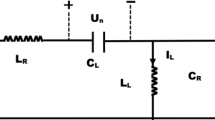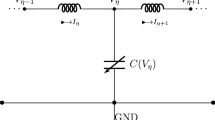Abstract
The envelope modulation of a monoinductance transmission line is reduced to generalized coupled Ginzburg-Landau equations, from which a single cubic-quintic Ginzburg-Landau equation containing derivatives with respect to the space variable in the cubic terms is deduced. We investigate the modulational instability of the space wave solutions of both the system and the single equation. For the generalized coupled Ginzburg-Landau system, we consider only the zero wave numbers of the perturbations whose modulational instability conditions depend only on the coefficients of the system and the wave numbers of the carriers. In this case, a modulational instability criterion is established, which depends on both the perturbation wave numbers and the carrier. We also study the coherent structures of the generalized coupled Ginzburg-Landau system and present some numerical results.
Similar content being viewed by others
References
A. C. Scott, Active and Nonlinear Wave Propagation in Electronics, Wiley, New York (1970).
E. Kengne, “Envelope modulational instability in a nonlinear dissipative transmission line,” Nonlin. Oscillations, 5, No. 1, 20–29 (2002).
A. C. Hicks, A. K. Common, and M. I. Sobhy, “Approximations to large amplitude solitary waves on nonlinear electrical lattice,” Physica D, 95, 167–186 (1996).
E. Kengne, “Ginzburg-Landau system of complex modulation equations for a distributed nonlinear-dispersive transmission line,” J. Phys. A: Math. Gen., 37, 6053–6066 (2004).
M. C. Cross and P. C. Hohenberg, “Pattern formation outside of equilibrium,” Rev. Mod. Phys., 65, 851–1112 (1993).
M. van Hecke and W. van Saarloos, “Convection in rotating annuli: Ginzburg-Landau equations with tunable coefficients,” Phys. Rev. E, 55, 1259–1262 (1997).
M. van Hecke, C. Storm, and W. van Saarloos, “Sources, sinks and wavenumber selection in coupled CGL equations and experimental implications for counter-propagating wave systems,” Physica D, 134, 1–47 (1999).
A. Doelman, Ph.D. Thesis, Utrecht (1990).
E. Kengne, S. T. Chui, and W. M. Liu, “Modulational instability criteria for coupled nonlinear transmission lines with dispersive elements,” Phys. Rev. E, 74, 036614-1–036614-10 (2006).
R. J. Deissler and H. R. Brand, “The effect of nonlinear gradient terms on localized states near a weakly inverted bifurcation,” Phys. Lett. A, 146, 252–255 (1990).
W. van Saarloos and P. C. Hohenberg, “Fronts, pulses, sources and sinks in generalized complex Ginzburg-Landau equations,” Physica D, 56, 303–367 (1992).
A. Doelman and W. Eckhaus, “Periodic and quasi-periodic solutions of degenerate modulation equations,” Physica D, 53, 249–266 (1991).
P. Holmes, “Structure of time-periodic solution of the Ginzburg-Landau equation,” Physica D, 23, 84–90 (1986).
E. Kengne, “Modified Ginzburg-Landau equation and Benjamin-Feir instability,” Nonlin. Oscillations, 6, No. 3, 346–356 (2003).
E. Kengne and W.M. Liu, “Exact solutions of the derivative nonlinear Schrödinger equation for a nonlinear transmission line,” Phys. Rev. E, 73, 026603-1–026603-8 (2006).
O. Thual and S. Fauve, “Localized structures generated by subcritical instabilities,” J. Phys. France, 49, 1829–1833 (1988).
S. Fauve and O. Thual, “Solitary waves generated by subcritical instabilities in dissipative systems,” Phys. Rev. Lett., 64, 282–284 (1990).
A. A. Kolyshkin, R. Vaillancourt, and I. Volodko, “Complex Ginzburg-Landau equation for suddenly blocked unsteady channel,” Cent. Rech. Math. Univ. Montréal, CRM-3194 (2005).
A. A. Kolyshkin, R. Vaillancourt, and I. Volodko, “Weakly nonlinear analysis of rapidly decelerated channel flow,” IASME Trans., 2, No. 7, 1157–1165 (2005).
C. K. R. T. Jones, T. Kapitula, and J. Powell, “Nearly real fronts in a Ginzburg-Landau equation, ” Proc. Roy. Soc. Edin. A, 116, 193–206 (1990).
M. van Hecke, “Building blocks of spatiotemporal intermittency,” Phys. Rev. Lett., 80, 1896–1899 (1998).
W. van Saarloos and P. C. Hohenberg, “Fronts, pulses, sources and sinks in generalized complex Ginzburg-Landau equations,” Physica D, 56, 303–367 (1992).
W. van Saarloos and P. C. Hohenberg, “Fronts, pulses, sources and sinks in generalized complex Ginzburg-Landau equations. Erratum,” Physica D, 69, 209 (1993).
N. Bekki and K. Nozaki, “Formations of spatial patterns and holes in the generalized Ginzburg-Landau equation,” Phys. Lett. A, 110, 133–135 (1985).
R. Conte and M. Musette, “Linearity inside nonlinearity: exact solutions to the complex Ginzburg-Landau equation,” Physica D, 69, 1–17 (1993).
P. Marcq, H. Chaté, and R. Conte, “Exact solutions of the one-dimensional quintic complex Ginzburg-Landau equation,” Physica D, 73, 305–317 (1994).
S. Popp, O. Stiller, I. Aranson, A. Weber, and L. Kramer, “Localized hole solutions and spatiotemporal chaos in the 1D complex Ginzburg-Landau equation,” Phys. Rev. Lett., 70, 3880–3883 (1993).
A. Doelman, “Breaking the hidden symmetry in the Ginzburg-Landau equation,” Physica D, 97, 398–428 (1996).
J. M. Soto-Crespo, N. Akhmediev, and G. Town, “Interrelation between various branches of stable solitons in dissipative systems. Conjecture for stability criterion,” Opt. Commun., 199, 283–293 (2001).
E. Kengne and C.N. Bame, “Wave modulation in nonlinear dissipative and dispersive transmission line, ” Far East J. Appl. Math., 16, No. 2, 213–232 (2004).
V. I. Arnold, Mathematical Methods of Classical Mechanics, Springer, New York (1978).
Author information
Authors and Affiliations
Additional information
Published in Neliniini Kolyvannya, Vol. 9, No. 4, pp. 451–489, October–December, 2006.
Rights and permissions
About this article
Cite this article
Kengne, E., Vaillancourt, R. Ginzburg-Landau system of complex modulation equations for distributed nonlinear dissipative transmission lines. Nonlinear Oscill 9, 438–477 (2006). https://doi.org/10.1007/s11072-006-0055-9
Received:
Issue Date:
DOI: https://doi.org/10.1007/s11072-006-0055-9




